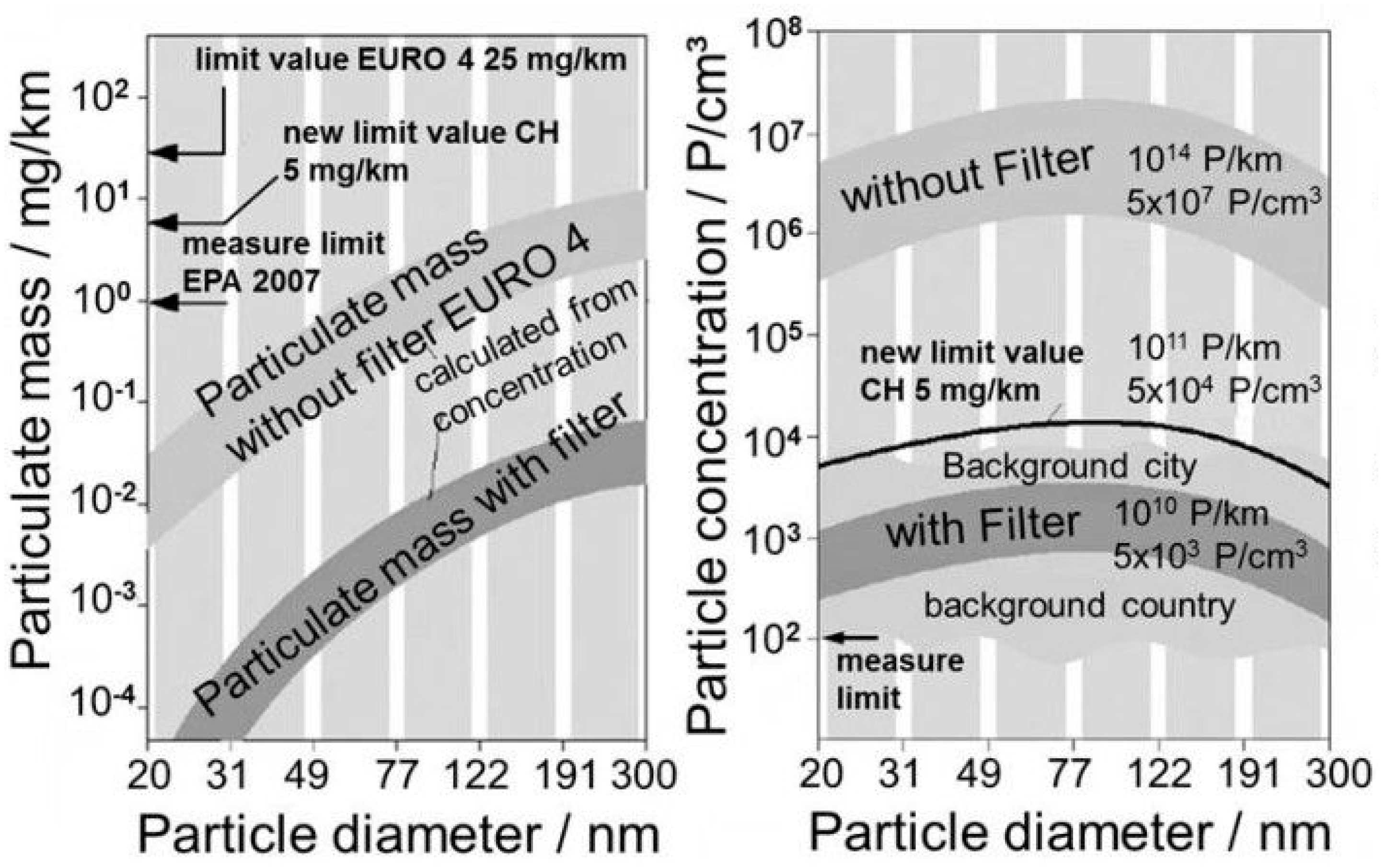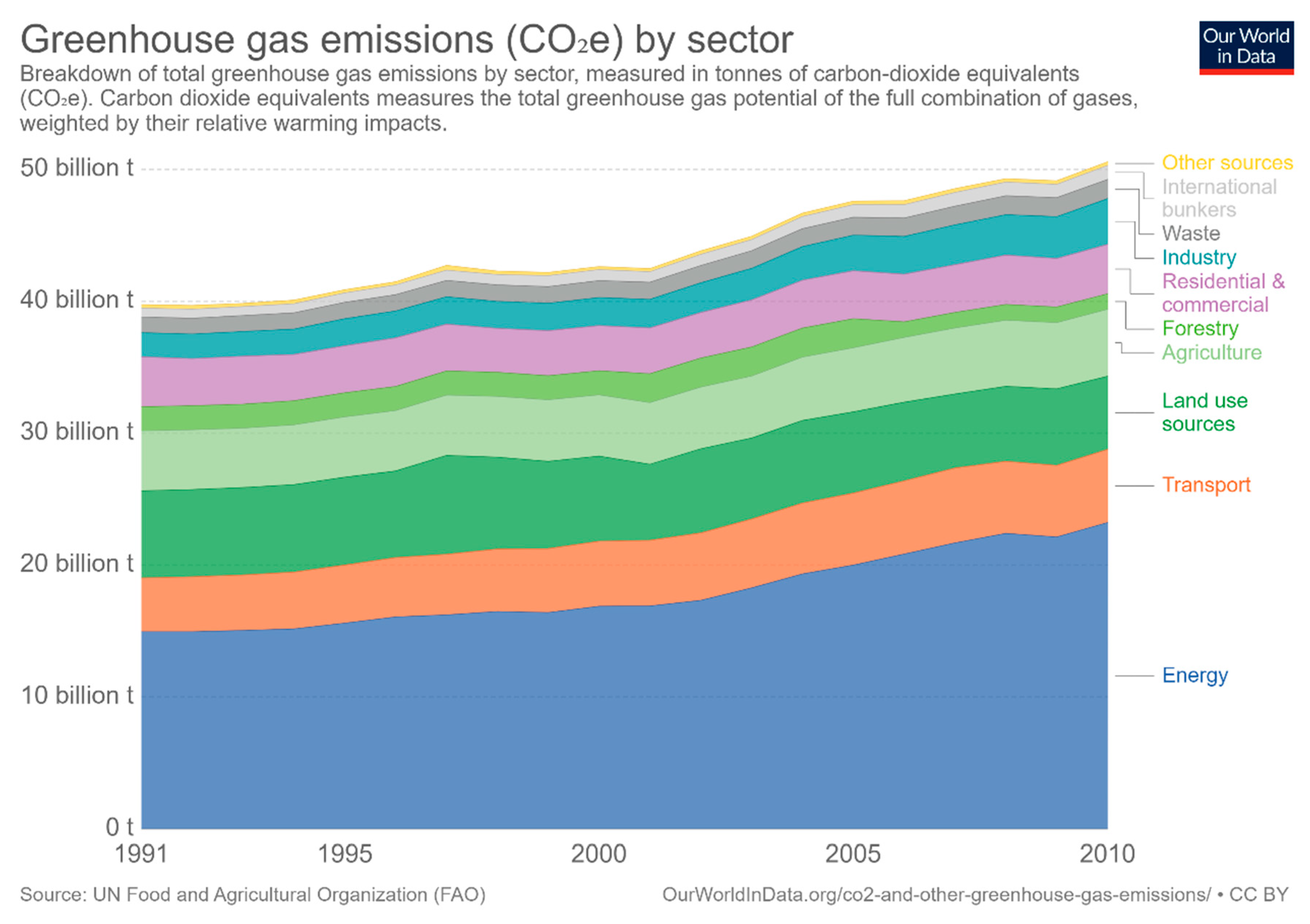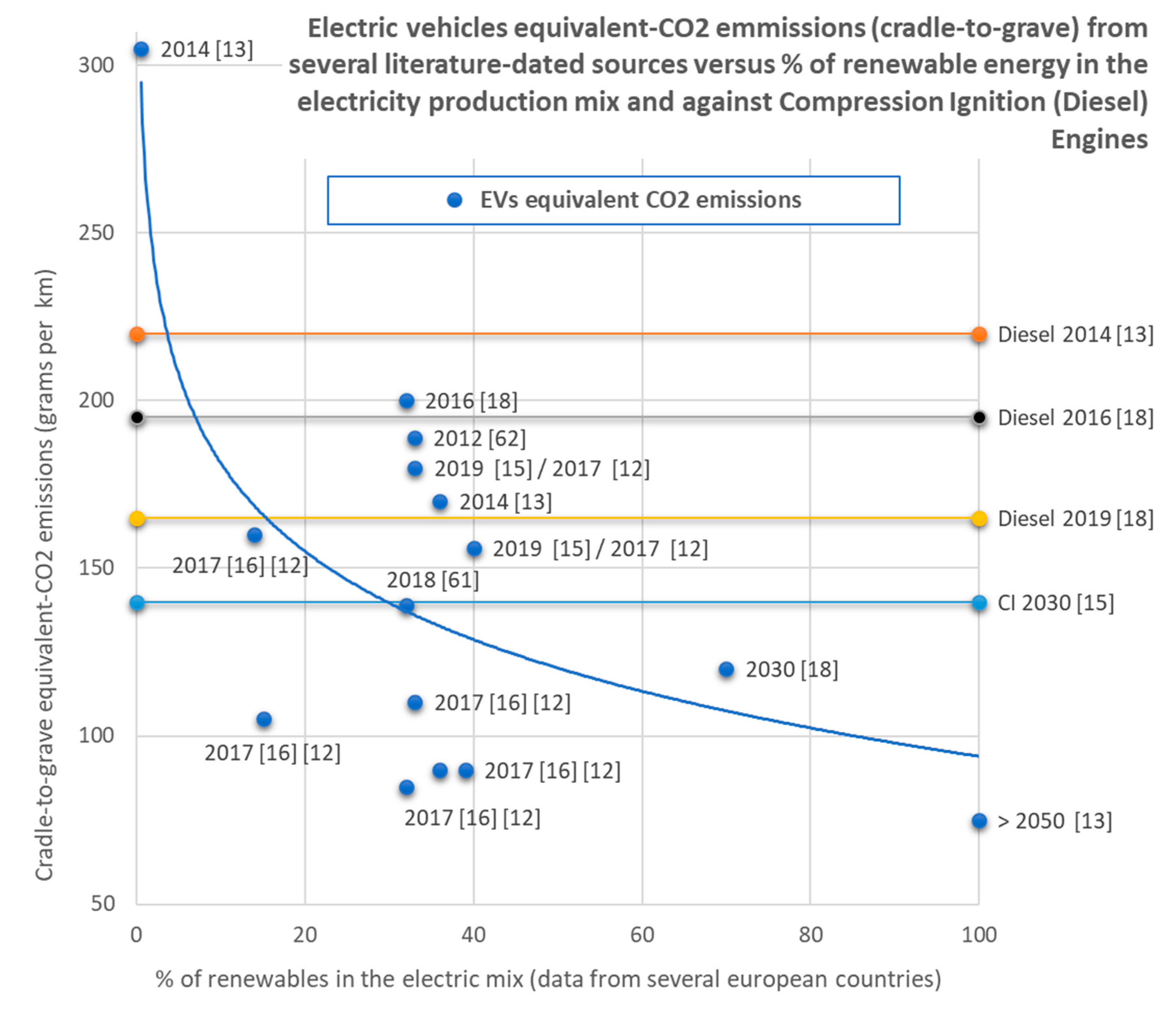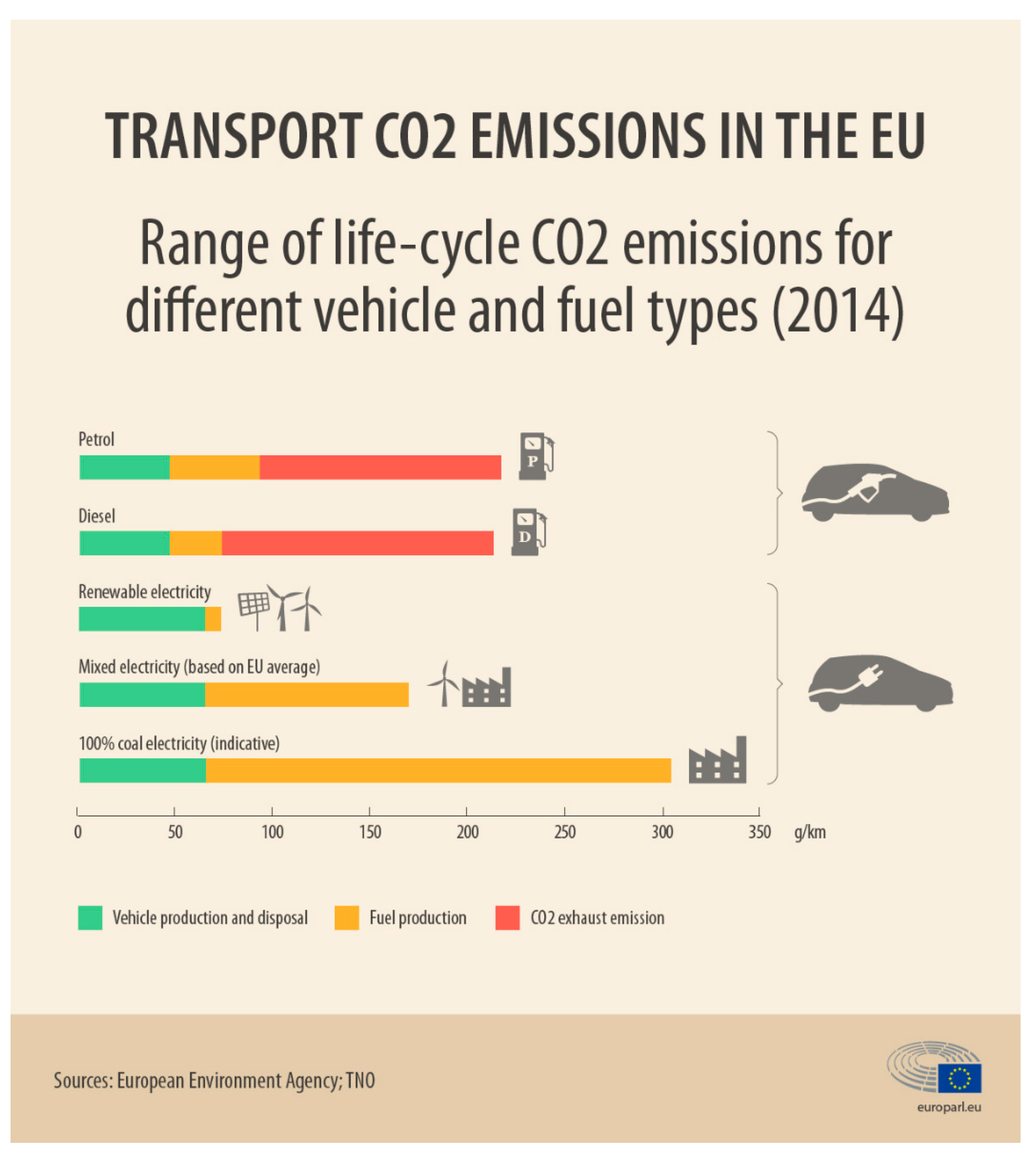Why the Development of Internal Combustion Engines Is Still Necessary to Fight against Global Climate Change from the Perspective of Transportation
1. What Is the Problem with ICE (Internal Combustion Engines)?
2. What Is the Problem with Electric Vehicles?
- ▪
- The charging time of the battery is unacceptably long for many users [19].
- ▪
- ▪
- ▪
- The supply of raw materials for manufacturing such as nickel, lithium, cobalt, copper, and manganese among others is an emergent obstacle as they are reaching high prices quickly and gaining in importance on geopolitical strategies. According to Sarah Maryssael, global manager of metal supplies for Tesla [24], the main problem is currently the supply of cobalt, which is necessary for the anode of lithium-ion batteries; a Tesla Model X needs 7 kg per vehicle and a Tesla Model 3 about 4.5 kg [25]. This mineral is extracted mainly from the Democratic Republic of Congo, where human rights are violated through child labor and mines stand out by their poor safety conditions, among others [26]. Then, cobalt reaches the international markets and its origin is diluted due to the low traceability of the production chain. Finally, it is fundamentally processed in China, what exemplifies the potential of this technology for further economic stress and uncertainties. What would be the cost of these materials refined in western countries with EU security, environmental, and health standards? It would probably be exorbitant.
3. What Can the New Generation of ICE Provide?
4. What Is Improving the Expectations in the New-Generation ICE?
Conflicts of Interest
References
- Serrano, J.R. Imagining the Future of the Internal Combustion Engine for Ground Transport in the Current Context. Appl. Sci. 2017, 7, 1001. [Google Scholar] [CrossRef]
- Ding, Y.; Sui, C.; Li, J. An Experimental Investigation into Combustion Fitting in a Direct Injection Marine Diesel Engine. Appl. Sci. 2018, 8, 2489. [Google Scholar] [CrossRef]
- Nguyen, D.V.; Duy, V.N. Numerical Analysis of the Forces on the Components of a Direct Diesel Engine. Appl. Sci. 2018, 8, 761. [Google Scholar] [CrossRef]
- EL MUNDO. España pretende prohibir las matriculaciones de coches diésel, gasolina e híbridos a partir de 2040. El Mundo. 2018. Available online: https://www.elmundo.es/motor/2018/11/13/5beab545e2704eb15b8b45ec.html (accessed on 15 October 2019).
- Financial Times. Dyson Presses UK Government for Earlier Petrol Car Ban. Financial Times. 2019. Available online: https://www.ft.com/content/9b078162-7195-11e9-bf5c-6eeb837566c5 (accessed on 15 October 2019).
- Brand, C. Beyond ‘Dieselgate’: Implications of unaccounted and future air pollutant emissions and energy use for cars in the United Kingdom. Energy Policy 2016, 97, 1–12. [Google Scholar] [CrossRef]
- Dey, S.; Caulfield, B.; Ghosh, B. The potential health, financial and environmental impacts of Dieselgate in Ireland. Transp. Plan. Technol. 2018, 41, 17–36. [Google Scholar] [CrossRef]
- Normativas de Emisiones Contaminantes en Europa (Versión Completa). Available online: https://www.dieselnet.com/standards/eu/ld.php#stds (accessed on 15 September 2019).
- Zhang, M.; Zhong, J.; Capelli, S.; Lubrano, L. Particulate Matter Emission Suppression Strategies in a Turbocharged Gasoline Direct-Injection Engine. J. Eng. Gas Turbines Power Trans. ASME 2017, 139, 102801. [Google Scholar] [CrossRef]
- Payri, R.; De La Morena, J.; Monsalve-Serrano, J.; Pesce, F.C. Alberto VassalloImpact of counter-bore nozzle on the combustion process and exhaust emissions for light-duty Diesel engine application. Int. J. Engine Res. 2019, 20, 46–57. [Google Scholar] [CrossRef]
- Lapuerta, M.; Ramos, Á.; Fernández-Rodríguez, D.; González-García, I. High-pressure versus low-pressure exhaust gas recirculation in a Euro 6 Diesel engine with lean-NOx trap: Effectiveness to reduce NOx emissions. Int. J. Engine Res. 2019, 20, 155–163. [Google Scholar] [CrossRef]
- BP Statistical Review of World Energy. June 2018. Available online: https://www.bp.com/en/global/corporate/energy-economics/statistical-review-of-world-energy.html (accessed on 15 September 2019).
- European Environment Agency. 2019. Available online: http://www.europarl.europa.eu/news/es/headlines/society/20190313STO31218/emisiones-de-co2-de-los-coches-hechos-y-cifras-infografia (accessed on 15 September 2019).
- Dwards, R.; Hass, H.; Larivé, J.-F.; Lonza, L.; Maas, H.; Rickeard, D. Well-to-Wheels Analysis of Future Automotive Fuels and Powertrains in the European Context; Report EUR 26236 EN. JRC Technical Reports; European Commission. Publications Office of the European Union: Brussels, Belgium, 2014. [Google Scholar] [CrossRef]
- Christoph, B.; Hans-Dieter, K.; Sinn, H.W. Kohlemotoren, Windmotoren und Dieselmotoren: Was zeigt die CO2-Bilanz? IFO Schnelld. 2019, 72, 40–54. [Google Scholar]
- Messagie, M. Life Cycle Analysis of the Climate Impact of Electric Vehicles. Transp. Environ. 2017. Available online: https://www.transportenvironment.org/publications/electric-vehicle-life-cycle-analysis-and-raw-material-availability (accessed on 15 September 2019).
- Available online: http://berkeleyearth.org/wp-content/uploads/2017/01/Europe-air-pollution.png (accessed on 15 September 2019).
- Blaich, M. El Motor Diésel y la Conflictiva Tendencia a la Electrificación. Interempresas.net. Automoción. 2019. Available online: http://www.interempresas.net/Sector-Automocion/Articulos/232843-El-motor-diesel-y-la-conflictiva-tendencia-de-la-electrificacion.html (accessed on 15 September 2019).
- Neaimeh, M.; Salisbury, S.D.; Hill, G.A.; Blythe, P.T.; Scoffield, D.R.; Francfort, J.E. Analysing the usage and evidencing the importance of fast chargers for the adoption of battery electric vehicles. Energy Policy 2017, 108, 474–486. [Google Scholar] [CrossRef]
- Los Coches Eléctricos y su Autonomía Limitada. Available online: https://www.ocu.org/coches/coches/noticias/autonomia-coches-electricos# (accessed on 15 October 2019).
- Autobahn Test: Tesla Model X Beats Audi e-tron & Jaguar I-Pace; Nextmove GmbH. Available online: https://nextmove.de/autobahn-test-tesla-model-x-beats-audi-e-tron-jaguar-i-pace/ (accessed on 15 September 2019).
- Tang, L.; Rizzoni, G.; Cordoba-Arenas, A. Battery Life Extending Charging Strategy for Plug-in Hybrid Electric Vehicles and Battery Electric Vehicles. IFAC Pap. Online 2016, 49, 70–76. [Google Scholar] [CrossRef]
- Blooma, I.; Colea, B.W.; Sohna, J.J.; Jonesa, S.A.; Polzina, E.G.; Battagliaa, V.S.; Henriksena, G.L.; Motlochb, C.; Richardsonb, R.; Unkelhaeuserc, T.; et al. An accelerated calendar and cycle life study of Li-ion cells. J. Power Sources 2002, 101, 238–247. [Google Scholar] [CrossRef]
- García, F. Alarma ante la posible escasez de baterías para vehículos eléctricos; El Mundo: Madrid, Spain, 2019; Available online: https://www.elmundo.es/motor/2019/05/08/5cd2ea68fdddff87418b4576.html (accessed on 15 October 2019).
- Fuentes, V. Tesla Prevé una Escasez Mundial de Minerales que son Clave Para Fabricar las Baterías de los Coches Eléctricos. Available online: https://www.motorpasion.com/tesla/tesla-preve-escasez-mundial-minerales-que-clave-para-fabricar-baterias-coches-electricos (accessed on 15 October 2019).
- Broom, D. The Dirty Secret of Electric Vehicles; Formative Content; World Economic Forum: Geneva, Switzerland, 2019; Available online: https://www.weforum.org/agenda/2019/03/the-dirty-secret-of-electric-vehicles/ (accessed on 15 September 2019).
- Boccardo, G.; Millo, F.; Piano, A.; Arnone, L.; Manelli, S.; Fagg, S.; Gatti, P.; Herrmann, O.E.; Queck, D.; Weber, J. Experimental investigation on a 3000 bar fuel injection system for a SCR-free non-road Diesel engine. Fuel 2019, 243, 342–351. [Google Scholar] [CrossRef]
- Puskar, M.; Kopas, M. System based on thermal control of the HCCI technology developed for reduction of the vehicle NOX emissions in order to fulfil the future standard Euro 7. Sci. Total Environ. 2018, 643, 674–680. [Google Scholar] [CrossRef]
- Marcin, N. Selected Issues of the Indicating Measurements in a Spark Ignition Engine with an Additional Expansion Process. Appl. Sci. 2017, 7, 295. [Google Scholar] [Green Version]
- Benajes, J.; Novella, R.; De Lima, D.; Tribotté, P. Analysis of combustion concepts in a newly designed two-stroke high-speed direct injection compression ignition engine. Int. J. Engine Res. 2015, 16, 52–67. [Google Scholar] [CrossRef]
- Luján, J.M.; Bermúdez, V.; Dolz, V.; Monsalve-Serrano, J. An assessment of the real-world driving gaseous emissions from a Euro 6 light-duty Diesel vehicle using a portable emissions measurement system (PEMS). Atmos. Environ. 2018, 174, 112–121. [Google Scholar] [CrossRef]
- Grigoratos, T.; Fontaras, G.; Giechaskiel, B.; Zacharof, N. Real world emissions performance of heavy-duty Euro VI Diesel vehicles. Atmos. Environ. 2019, 201, 348–359. [Google Scholar] [CrossRef]
- Green Car Congress. ADAC Testing Finds New Diesel Cars Cleaner than Required; Euro 6c and 6d-Temp Vehicles Well below the Permissible NOx Limits. Available online: https://www.greencarcongress.com/2019/02/201902-22-adac.html (accessed on 15 September 2019).
- Serrano, J.R.; Novella, R.; Gomez-Soriano, J.; Martinez-Hernándiz, P.J. Computational methodology for knocking combustion analysis in compression ignited advanced concepts. Appl. Sci. 2018, 8, 1707. [Google Scholar] [CrossRef]
- Chiatti, G.; Chiavola, O.; Frezzolini, P.; Palmieri, F. On the link between diesel spray asymmetry and off-axis needle displacement. Appl. Sci. 2017, 7, 375. [Google Scholar] [CrossRef]
- Sangik, H.; Juhwan, H.; Jinwook, L. A Study on the Optimal Actuation Structure Design of a Direct Needle-Driven Piezo Injector for a CRDi Engine. Appl. Sci. 2017, 7, 320. [Google Scholar] [Green Version]
- Dimitriou, P.; Burke, R.; Zhang, Q.; Copeland, C.; Stoffels, H. Electric turbocharging for energy regeneration and increased efficiency at real driving conditions. Appl. Sci. 2017, 7, 350. [Google Scholar] [CrossRef]
- Serrano, J.R.; Arnau, F.J.; Dolz, V.; Tiseira, A.; Lejeune, M.; Auffret, N. Analysis of the capabilities of a two-stage turbocharging system to fulfil the US2007 anti-pollution directive for heavy duty diesel engines. Int. J. Automot. Technol. 2008, 9, 277–288. [Google Scholar] [CrossRef]
- Fernández-Yáñez, P.; Armas, O.; Gómez, A.; Gil, A. Developing computational fluid dynamics (CFD) models to evaluate available energy in exhaust systems of diesel light-duty vehicles. Appl. Sci. 2017, 7, 590. [Google Scholar]
- Huang, Y.; Surawski, N.C.; Organ, B.; Zhou, J.L. Fuel consumption and emissions performance under real driving: Comparison between hybrid and conventional vehicles. Sci. Total Environ. 2019, 659, 275–282. [Google Scholar] [CrossRef]
- Andwari, A.M.; Pesiridis, A.; Karvountzis-Kontakiotis, A.; Esfahanian, V. Hybrid electric vehicle performance with Organic Rankine Cycle Waste Heat Recovery system. Appl. Sci. 2017, 7, 437. [Google Scholar] [CrossRef]
- Benajes, J.; García, A.; Monsalve-Serrano, J.; Boronat, V. Dual-fuel combustion for future clean and efficient compression ignition engines. Appl. Sci. 2016, 7, 36. [Google Scholar] [CrossRef]
- Mustafa, A.; Ahmet, I.; Çelik, M. The Impact of Diesel/LPG Dual Fuel on Performance and Emissions in a Single Cylinder Diesel Generator. Appl. Sci. 2018, 8, 825. [Google Scholar] [Green Version]
- Torregrosa, A.J.; Broatch, A.; Novella, R.; Gomez-Soriano, J.; Mónico, L.F. Impact of gasoline and diesel blends on combustion noise and pollutant emissions in premixed charge compression ignition engines. Energy 2017, 137, 58–68. [Google Scholar] [CrossRef]
- Bermúdez, V.; Serrano, J.R.; Piqueras, P.; Sanchis, E. On the impact of particulate matter distribution on pressure drop of wall-flow particulate filters. Appl. Sci. 2017, 7, 234. [Google Scholar] [CrossRef]
- Qiao, Q.; Zhao, F.; Liu, Z.; Jiang, S.; Hao, H. Comparative Study on Life Cycle CO2 Emissions from the Production of Electric and Conventional Vehicles in China. Energy Procedia 2017, 105, 3584–3595. [Google Scholar] [CrossRef]
- ACEA—The Automobile Industry Pocket Guide 2018–2019. Available online: https://www.acea.be/publications/article/acea-pocket-guide (accessed on 15 September 2019).
- Kan, H.; Chen, R.; Tong, S. Ambient air pollution, climate change, and population health in China. Environ. Int. 2012, 42, 10–19. [Google Scholar] [CrossRef]
- Mayer, A.; Wyser, M.; Czerwinski, J. Erfahrungen mit Partikelfilter-Nachrüstungen bei Baumaschinen in der Schweiz. In Proceedings of the FAD-Konferenz, Dresden, Germany, 12–13 November 2003. [Google Scholar]
- Has the Government Got It Wrong on ‘dirty Diesel’ Cars? Tests Show Some BMW, Mercedes and Vauxhall Models Produce almost ZERO Harmful NOx Emissions. Available online: https://www.thisismoney.co.uk/money/cars/article-6733271/Are-diesel-cars-really-dirty-Tests-reveal-models-produce-zero-NOx-emissions.html (accessed on 26 September 2019).
- Serrano, J.R.; Piqueras, P.; Abbad, A.; Tabet, R.; Bender, S.; Gomez, J. Impact on Reduction of Pollutant Emissions from Passenger Cars when Replacing Euro 4 with Euro 6d Diesel Engines Considering the Altitude. Energies. 2019, 12, 1278. [Google Scholar] [CrossRef]
- Ritchie, H.; Roser, M. CO₂ and Greenhouse Gas Emissions. Available online: https://ourworldindata.org/co2-and-other-greenhouse-gas-emissions (accessed on 15 September 2019).
- Cormos, A.M.; Cormos, C.C. Techno-economic evaluations of post-combustion CO2 capture from sub- and super-critical circulated fluidized bed combustion (CFBC) power plants. Appl. Therm. Eng. 2017, 127, 106–115. [Google Scholar] [CrossRef]
- Kramer, U. Defossilizing the Transportation Sector. Options and requirements for Germany. Fvv Prime Movers. Technologies. 2018. Forschungsvereinigung Verbrennungskraftmaschinen e.V. Lyoner Strasse 18 60528 Frankfurt/ M., Germany. www.fvv-net.de/en. Available online: https://www.fvv-net.de/fileadmin/user_upload/medien/materialien/FVV_Future_Fuels_Study_report_Defossilizing_the_transportation_sector_R586_final_v.3_2019-06-14__EN.pdf (accessed on 15 October 2019).
- Hamad, E.Z.; Al-Sadat, W.I. Apparatus and Method for Oxy-combustion or Fuels in Internal Combustion Engines. U.S. Patent 2013/0247886 A1, 26 September 2013. [Google Scholar]
- Sun, H.; Wang, W.; Koo, K.P. The practical implementation of methanol as a clean and efficient alternative fuel for automotive vehicles. Int. J. Engine Res. 2019, 20, 350–358. [Google Scholar] [CrossRef]
- Desantes, J.M.; Benajes, J.; Serrano, J.R.; Arnau, F.; Garcia-Cuevas, L.M.; Serra, J.M.; Catalán, D. Motor de Combustión Interna; OEPM Madrid: Madrid, Spain, 2019; 201930285.
- Johnson, T.; Joshi, A. Review of Vehicle Engine Efficiency and Emissions. Sae Tech. Pap. 2018. [Google Scholar] [CrossRef]
- Nieuwste Diesels Reinigen de Lucht. Available online: https://autonieuws.be/uitlaat/4756-nieuwste-diesels-reinigen-de-lucht (accessed on 15 September 2019).
- Wissenschaftliche Gesellschaft für Kraftfahrzeug-und Motorentechnik e.V. The Future of the Combustion Engine/Assessment of the Diesel Engine Situation; WKM: Berlin, Germany, 2017. [Google Scholar]
- Aparicio, F.; Casanova, J.; López, J.M.; Payri, F.; Tinaut, F.V.; Wolff, G. El Automóvil en la Movilidad Sostenible; Informe ASEPA; ASEPA: Madrid, Spain, 2018. [Google Scholar]
- Troy, R.; Singh, H.B.; Majeau-Bettez, G.; Strømman, A.H. Comparative Environmental Life Cycle Assessment of Conventional and Electric Vehicles. J. Ind. Ecol. 2012, 17, 53–64. [Google Scholar] [CrossRef]
- Diesel-PKW Dürfen Nach Erfolgreicher Hardware-Nachrüstung Weiter Einfahren. Available online: https://www.bmu.de/pressemitteilung/bundestag-beschliesst-einheitliche-regeln-fuer-umgang-mit-verkehrsverboten/ (accessed on 15 October 2019).
- Euro 6D-Temp Diesel Like Petrol. France Tries to Adapt the Anti-Pollution Stamps. Available online: https://www.diesel-international.com/automotive/france-euro-6d-temp-diesel/ (accessed on 15 October 2019).





© 2019 by the authors. Licensee MDPI, Basel, Switzerland. This article is an open access article distributed under the terms and conditions of the Creative Commons Attribution (CC BY) license (http://creativecommons.org/licenses/by/4.0/).
Share and Cite
Serrano, J.R.; Novella, R.; Piqueras, P. Why the Development of Internal Combustion Engines Is Still Necessary to Fight against Global Climate Change from the Perspective of Transportation. Appl. Sci. 2019, 9, 4597. https://doi.org/10.3390/app9214597
Serrano JR, Novella R, Piqueras P. Why the Development of Internal Combustion Engines Is Still Necessary to Fight against Global Climate Change from the Perspective of Transportation. Applied Sciences. 2019; 9(21):4597. https://doi.org/10.3390/app9214597
Chicago/Turabian StyleSerrano, José Ramón, Ricardo Novella, and Pedro Piqueras. 2019. "Why the Development of Internal Combustion Engines Is Still Necessary to Fight against Global Climate Change from the Perspective of Transportation" Applied Sciences 9, no. 21: 4597. https://doi.org/10.3390/app9214597
APA StyleSerrano, J. R., Novella, R., & Piqueras, P. (2019). Why the Development of Internal Combustion Engines Is Still Necessary to Fight against Global Climate Change from the Perspective of Transportation. Applied Sciences, 9(21), 4597. https://doi.org/10.3390/app9214597







